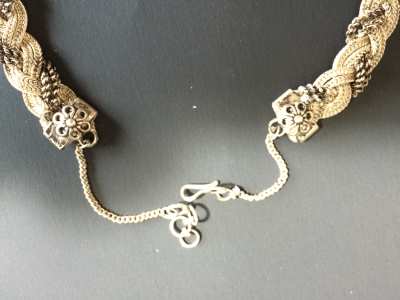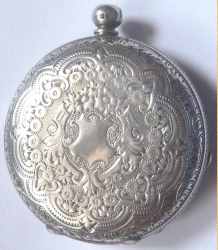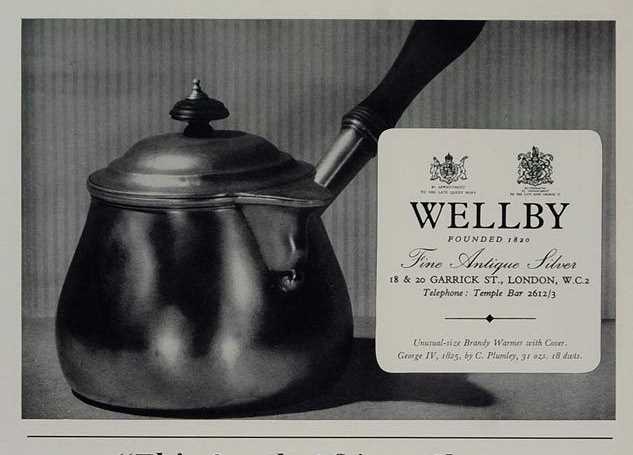YOUR GUIDE TO JUNE NEWSLETTER:
articles
new members
members' window
mail to ASCAS
replies to questions
a page per month
a silversmith per month
a word per month
a book on my shelf
a crest per month
contributors to this Newsletter
search engine
disclaimer and privacy policy
A new article for
ASCAS website

Robert Massart presents:
Parisian Goldsmiths and Jewellery Houses of the 19th and 20th Century

Les Maisons Parisiennes d'Orfèvrerie et de Bijouterie du XIXe et du XXe siècle

Parisian silversmiths and jewellers are inextricably linked with the heart of historical Paris, named "Le Marais" (the swamp). At first the quarter was the shopping center for the
royal court and the aristocracy who bought luxurious jewels and silverware. Thanks to the quality of their production, some workshops managed to become appointed purveyor to the king and his court and were rewarded for their talent by prestigious commissions.
Later "Le Marais" was abandoned by the aristocracy and the court, whereafter the quarter was invaded by artisans and small industry.
During the 19th century the famous goldsmith and jewellery houses boomed, due to the new rich and famous, who could afford to buy luxurious jewellery and silverware. The emergence of these
companies however, constrained the smaller shops to close. Indeed, the goldsmith and jewellery shops evolved during their lifetime, encountering growth, moments of fortune as well as financial
problems. When the manager of an enterprise retired and voluntary liquidated the company, or after a bankruptcy, competitors took over the firm in difficulty, bought drawings of the patterns,
dies, and/or tools and machines, or the complete inventory was sold at public auctions and vanished without leaving traces. At present only a few famous houses are still active in Paris, as
there are Odiot, Puiforcat and Lapparra....
click here
 cliquez ici
cliquez ici

New members
Welcome to new ASCAS members:
Diana Modesto - Australia
Members' Window # 113

Christophe Ginter presents:
Outstanding European Silver (1): The Filigree of Porto - Gondomar (Portugal)

Orfèvrerie remarquable européenne (1): Le filigrané de Porto - Gondomar (Portugal)

This is the first in a series of short articles devoted to the main locations engaged in Europe in the working of precious metals and jewelry.
The present page is dedicated to Porto (Portugal) goldsmiths and their workshops, most of them located in Gondomar, in the suburbs east of the town.
The activity involves a group of about 60 craftsmen still active in the production of a variety of best quality objects and jewels in sterling silver or vermeil (gilt sterling silver)
using the tradition of "filigree" technique ( filigree is the process and type of design that uses twisted
wire to create delicate, lacy, openwork jewelry)....
click here
 cliquez ici
cliquez ici

|
Mail to ASCAS:
e-mail
silverassociation@yahoo.it
Leona Ambuldeniya writes:
... Can someone please help me to identify the maker and period of this sterling silver serpent necklace?
I found this at a church basement sale. When I bought it, it looked dirty and brown and I thought it was gold plated.
When I started cleaning it, the dirt fell away and it turned silver.
There are no markings so I acid tested the necklace and it turned out to be sterling silver with some black paint like material on some of the silver braids.
Thank you
Leona Ambuldeniya
Andreas Puls writes:
... I enjoyed your silver website, there is a lot to know about the subject.
Could you have a look at my attached picture please, I would love your opinion, I can't find any info on the maker or date of this spoon.
Thank you
Andreas Puls
Dennis Rogers writes:
... I'm looking for information about the maker of this watch
Thanks in advance for your help.
Dennis Rogers
The hallmark is Chester 1886. The 1886 register is missing in Chester Assay Office. Anyway I believe that the maker is Louis Weill & Henry Harburg, Holborn Circus, London.
They entered a similar mark in Birmingham Assay Office in 1883
Giorgio Busetto
"A PAGE per MONTH"
In this column we presents a page obtained from makers'
brochures, books, auction catalogs, advertising or whatever
other printed paper, related to silver, that may be of interest
for ASCAS members.
The images will be published at a "low resolution" level and for
private and personal use only.
This column is published under the kind permission of Giorgio
Busetto's website

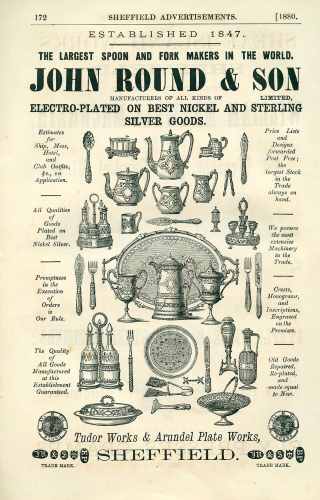 |
This month ASCAS presents an ancient advertisement of:
JOHN ROUND & SON
The firm was established by John Round in Sheffield in 1847 and became John Round & Son Ltd in 1874. In 1886 the business of Ridge, Allcard & Co (Lions Works, Eyre
Lane) was amalgamated and John Ridge became the manager maintaining this role for about 25 years. The business was purchased in the 1930s by Joseph Rodgers & Sons.
ADVERTISEMENTS IN SILVER - SILVER ADVERTISING
section of www.silvercollection.it website
|
"A WORD per MONTH"
In this column we
present an abstract from a page of the "What is? Silver Dictionary"
courtesy of


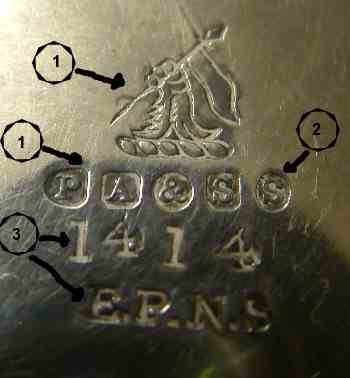
(1) WHO: the maker is PHILIP ASHBERRY & SONS identified by the Figural trade mark (paw feet with banner) and the initials PA&S
(2) WHERE: the firm was active in Sheffield, identified by the "S" (on the right, after the maker's initials)
(3) WHAT: the piece is identified by the stock (production) number 1414 and the base metal is Nickel Silver (E.P.N.S)
|
HOW TO READ, DECRYPT AND IDENTIFY
THE MARKS ON ENGLISH SILVERPLATE AND ELECTROPLATED SILVER
QUICK ANSWERS TO YOUR QUESTIONS
EPNS and EPBM are the acronyms more frequently used to identify English silverplate, EPNS stands for Electro Plated Nickel Silver and EPBM stands for Electro Plated
Britannia Metal..... MORE...
WHAT ABOUT A NUMBER NEXT TO THE MARK?
This is the production/pattern/stock number used by the firm to identify the item. Never assume these numbers as date of production of the piece
A1 OR AI, WHAT MEANS?
This is a code identifying the quality of the plating. "A1" or "AI" is the best quality (next A, B, C and D)
MORE
|
"A SILVERSMITH per MONTH"
|
|
D & J WELLBY LTD
The business took origin from the partnership between Joseph Clements and John Wellby at 57 King Street, Soho as Gold and Silver refiners and dealers. The partnership, founded in 1827, lasted until
August 6, 1828, when was dissolved by mutual consent.
The activity was continued at the same address by John Wellby, who entered his first mark at Goldsmiths' Hall in 1834.
New marks were entered in 1863 by Daniel Wellby and John Henry Wellby. The firm, active at 20 Garrick Street, Covent Garden (1879), continued to expand its activity and in 1896/1897 was converted into a limited liability company under
the name D & J Wellby Ltd. At that time the directors were Daniel Wellby, John Henry Wellby (d. 1917), Edward Henry Wellby and Howard Wellby (b.1867 - d.1934).
New marks were entered in London (1896) and Sheffield (1897)....
more
|
"A CREST per MONTH"
ROBERTSON
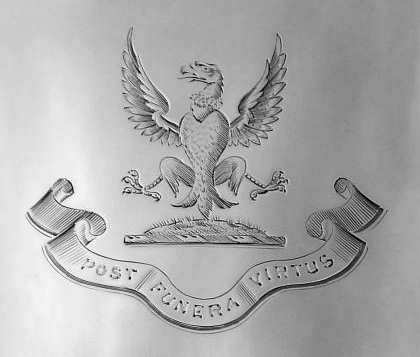
|
The crest of Robertson Family: A phoenix in flames
The Latin motto is "Post funera virtus" (Virtue survives death)
The crest was found on a cigarette case, date Birmingham 1876, maker George Unite

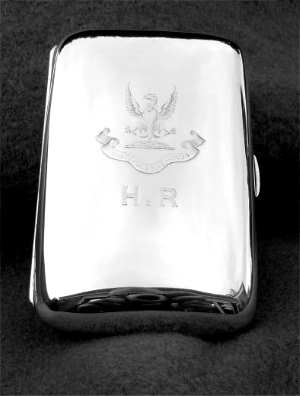
|
Closing our June 2016 edition of ASCAS Newsletter I hope
you have appreciated its content.
Your comments, suggestions and advice will be of great help.
My thanks to Leona Ambuldeniya, Geldolph Everts, Christophe Ginter, Robert Massart, Andreas Puls and Dennis Rogers for their precious contributions.
Giorgio Busetto
Secretary
DISCLAIMER AND PRIVACY POLICY
ASCAS is a community of people having a common
interest in antique silver.
It is a non-profit association without commercial links.
Membership is open to whomever has a true interest in
this subject matter.
ASCAS has no real property and no fees are requested nor
accepted from members.
ASCAS keeps in touch with its members only through
periodical newsletters, e-mails and web-site updating
and ignores and is not responsible for any other
activity pursued by its members.
Likewise, ASCAS is not responsible for opinions,
evaluation and images displayed, and in any form
published or supplied for publication, by its members
who, in any case, maintain the property of their works
and assure the respect of national and international
legislation about Intellectual Property.
ASCAS does not have the full addresses of its members (only
town, country and e-mail address are requested for
membership).
ASCAS handles and protects with care its members' e-mail
addresses, will not disclose the addresses to third
parties, will use this information only to reply to
requests received from members and for communications
strictly related to its activity.
These rules are expressly accepted by submitting the
membership request.
|
|
 newsletter
# 145 June 2016
newsletter
# 145 June 2016








